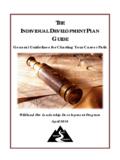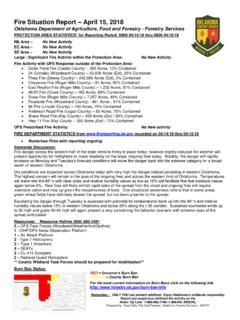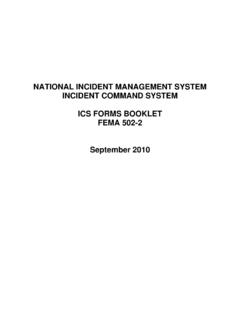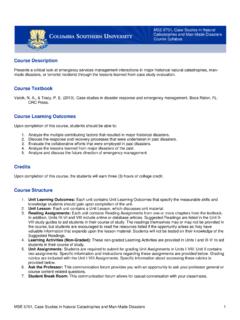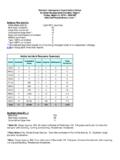Transcription of Fuel Moisture Sampling Guide - The Wildland Fire Assesment ...
1 fuel Moisture Sampling Guide Updated April 2007 Bureau of Land Management Utah State Office Salt Lake City, Utah Prepared by: Jolie Pollet and Annie Brown Table of Contents Introduction ..1 Dead fuel Live fuel Understanding Plant Phenology of Selected Species to Aid in Collecting Live fuel Moisture Pinyon pine and Utah Gambel s Getting Started Sampling fuel Site Selection for Establishing Seasonal Site Selection for Prescribed Personnel for fuel Sampling Period and Number of Samples to Equipment needed for Collecting fuel Sampling Methods for Dead Sampling Methods for Live Weighing the Drying the Calculating Moisture Guidelines for fire Behavior and Tactics Based on Live fuel Moisture Values.
2 17 Common Sources of Reporting Requirements for BLM Units in Appendices Appendix A fuel Moisture Site Description Appendix B Worksheet for Determining Number of Appendix B Appendix C fuel Moisture Content Appendix D - Equipment Vendors, Suggested Equipment and Estimated Introduction The strong influence that variations in live and dead fuel Moisture content have on fire behavior has been recognized by Wildland fire managers. fuel moistures help drive fire suppression staffing and funding decisions; and guidelines for prescribed burning call for accurate values for the Moisture content of fuels (USDI 2000).
3 This handbook aims to synthesize the existing literature on fuel Moisture into uniform Sampling procedures for BLM units in Utah. Although live and dead fuels are a major influence on fire behavior, they are only two of many fuel and environmental parameters affecting fire behavior. Consequently, live and dead fuel Moisture alone cannot be used to adequately evaluate potential fire hazard and fire behavior. Used in conjunction with the effects of other fire behavior influences, knowledge of the values and trends of fuel moistures can greatly improve the accuracy of fire hazard, fire behavior, and fire effects predictions for use in fire suppression, fire prevention, prescribed fire activities, and fire rehabilitation.
4 For most fuels, no computational procedure yet developed is adequate to estimate their Moisture content. Direct Sampling of fuels is the best alternative. Regardless of the purpose of fuel Moisture Sampling , a standard procedure for collecting, processing, calculating and reporting the Moisture content is necessary. Errors in estimating representative fuel Moisture content on a site can potentially be introduced during every step of the process if defined procedures are not followed. Further, the collection of appropriate material must be standardized to achieve accurate estimates.
5 This Guide presents a standard procedure for collecting and handling samples from various fuel complexes, with particular emphasis on selected fuels in Utah s BLM-administered lands. The basis of live fuel Moisture causes some confusion among fire practitioners ( , how can fuel have more than 100% Moisture ?). Moisture content of Wildland fuels is expressed in relation to dry weight, not just the proportion of water in the fuel . It is the dry material that provides the heat to evaporate water so that the fuel will burn. The definition of Moisture content used here is the ratio of the weight of the water contained to the dry weight of the material, expressed as a percentage.
6 The simple formula for percent Moisture content is: Weight of water in sample (100) = percent Moisture content Dry weight of sample 2 The objectives of fuel Moisture Sampling and reporting are to: Assist in fire behavior predictions for wildfires and fire use Provide a basis for severity funding Determine whether a site is in prescription for prescribed burning Aid in determining post- fire resource effects Determine drought or drying trends Validate NFDRS calculated outputs Dead fuel Moisture Dead fuels consist of: small to large diameter down and dead woody fuels (1-, 10-, 100-, and 1000-hour fuels); dead grasses and forbs; frost-killed leaves still attached to live stems, such as on Gambel s oak; and surface litter such as fallen leaves and needles.
7 Duff and soil are also categorized as dead fuels for the purposes of this Guide . One-hour fuels can be estimated from environmental conditions ( fire Behavior Field Reference Guide 1992). Ten-hour fuel sticks are standard at all NFDRS Sampling stations and provide a relative measure of drying. 100-hour and 1000-hour fuels are typically determined by field Sampling . Duff may be sampled to determine its Moisture content. Many vital plant parts rhizomes, roots, tubers reside in duff. Although soil is not usually considered to be a fuel , some surface soil samples are often collected for Moisture content because sprouting parts of many plant species are concentrated in the surface of the soil rather than in the duff.
8 Additionally, most BLM sites in Utah have very little or no duff and soil Moisture content may be the best way to evaluate the effects of fire below the ground surface. Live fuel Moisture Live fuels consist of: conifer needles; twigs and leaves of shrubs (evergreen and deciduous); and green (live) grasses and forbs. Changes in live fuel Moisture content are related to the physiological activity of the vegetation, and this activity is greatly influenced by soil Moisture and the soil and air temperature. When precipitation is deficient, less new growth is produced and peak Moisture in the living material can be less than during more moist years.
9 If soil Moisture deficiency persists through the summer, live fuel Moisture can drop more rapidly. Soil and air temperatures affect the time new growth starts and the level of Moisture attained by the vegetation. In situations when soil Moisture is not limiting, new growth 3will start earlier and often reach a higher level of Moisture when the weather in late winter and spring is warm than when the weather is cold. Other factors that affect soil and air temperatures, such as slope, aspect, and elevation also affect the amount of new growth, the timing of growth, and the level of Moisture in the living material.
10 The Moisture patterns of different plant species vary. Moisture variations are also found between plants of the same species in the same locale and often in material taken from different heights and aspects on the same plant. Site quality also affects live fuel Moisture ; shrubs on good sites tend to produce more new growth, have higher Moisture levels, and decrease in Moisture more slowly during the summer than shrubs on poor sites (Countryman and Dean 1979). Live plants may either suppress combustion or contribute to it, depending on their Moisture content and flammability of chemical compounds contained in the plant.


